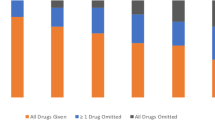Abstract
Purpose
To evaluate the feasibility of 1-(4-amino- 2-methyl-5-pyrimidynyl) methyl-3-(2-chloroethyl)-3-nitrosourea hydrochloride (ACNU) of pre-treated procarbazine for elderly patients with newly diagnosed glioblastomas.
Patients and methods
From January 2004 to March 2005, 7 patients with glioblastoma were enrolled. After maximal surgical resection, patients were treated with two to four cycles of procarbazine (100 mg/m2 for day 1 to 5), ACNU (80 mg/m2/day1 for day 5), cepharantine (70 mg for day 5 and 12) and vincristine (1.4 mg/m2 for day 5 and 12).
Results
Significant toxicities of this regimen, including infectious toxicities, are described. Among the 7 patients enrolled, there were 6 patients were died, and one was still alive with disease at 13 months. The 6-month progression-free survival and 1-year overall survival are 29% (95% CI, 16% to 73%) and 29% (95% CI, 16% to 73%), respectively.
Conclusion
The chemotherapy regimen is active but too toxic for elderly patients with newly diagnosed glioblastoma.
Similar content being viewed by others
References
Devaux BC, O’Fallon JR, Kelly PJ (1993) Resection, biopsy, and survival in malignant glial neoplasms: a retrospective study of clinical parameters, therapy, and outcome. J Neurosurg 78:767–775
Davis FG, Freels S, Grutsch J, Barlas S, Brem S (1998) Survival rates in patients with primary malignant brain tumors stratified by patient age and tumor histological type: an analysis based on surveillance, epidemiology, and end results (SEER) data, 1973–1991. J Neurosurg 88:1–10
Mohan DS, Suh JH, Phan JL, Kupelian PA, Cohen BH, Barnett GH (1998) Outcome in elderly patients undergoing definitive surgery and radiation therapy for supratentorial glioblastoma multiforme at a tertiary care institution. Int Radiat Oncol Biol Phys 42:981–987
Mangiola A, Maira G, De Bonis P, Porso M, Pettorini B, Sabatino G, Anile C (2006) Glioblastoma multiforme in the elderly: a therapeutic challenge. J Neurooncol 76:159–163
Valavanis C, Souliotis VL, Krytopoulos SA (1994) Differential effects of procarbazine and methylnitrosourea on the accumulation of O6-methylguanine and the depletion and recovery of O6-alkylguanine–DNA alkyltransferase in rat tissues. Carcinogenesis 15:1681–1688
Hirai M, Tanaka K, Shimizu T, Tanigawara Y, Yasuhara M, Hori R, Kakehi Y, Yoshida O, Ueda K, Komano T (1995) Cepharantin, a multidrug resistant modifier, is a substrate for p-glycoprotein. J Pharmacol Exp Ther 275:73–78
Ogawa K, Yoshii Y, Inoue O, Toita T, Saito A, Kakinohana Y, Adachi G, Ishikawa Y, Kin S, Murayama S (2003) Prospective trial of radiotherapy after hyperbaric oxygenation with chemotherapy for high-grade gliomas. Radiother Oncol 67:63–67
Chinot OL, Barrie M, Frauger E, Dufour H, Figarella-Branger D, Palmari J, Braguer D, Hoang-Xuan K, Moktari K, Peragut JC, Martin PM, Grisoli F (2004) Phase II study of temozolomide without radiotherapy in newly diagnosed glioblastoma multiforme in an elderly population. Cancer 100:2208–2214
Pierga JY, Hoang-Xuan K, Feuvret L, Simon JM, Cornu P, Baillet F, Mazeron JJ, Delattre JY (1999) Treatment of malignant gliomas in the elderly. J Neuro Oncol 43:187–193
Gilbert MR, Friedman HS, Kuttesch JF, Prados MD, Olson JJ, Reaman GH, Zaknoen SL (2002) A phase II study of temozolomide in patients with newly diagnosed supratentorial malignant glioma before radiation therapy. Neuro Oncol 4:261–267
Brandes AA, Vastola F, Basso U, Berti F, Pinna G, Rotilio A, Gardiman M, Scienza R, Monfardini S, Ermani M (2003) A prospective study on glioblastoma in the elderly. Cancer 97:657–662
Guyotat J, Signorelli F, Frappaz D, Madarassy G, Ricci AC, Bret P (2000) Is reoperation for recurrence of glioblastoma justified? Oncol Rep 7:899–904
Grant R, Liang BC, Page MA, Crane DL, Greenberg HS, Junck L (1995) Age influences chemotherapy response in astrocytomas. Neurology 45:929–933
Author information
Authors and Affiliations
Corresponding author
Rights and permissions
About this article
Cite this article
Terasaki, M., Abe, T., Miyagi, N. et al. Feasibility and response to 1-(4-amino-2-methyl-5-pyrimidynyl) methyl-3-(2-chloroethyl)-3-nitrosourea hydrochloride chemotherapy with pre-treated procarbazine for elderly patients with newly diagnosed glioblastoma. J Neurooncol 81, 265–269 (2007). https://doi.org/10.1007/s11060-006-9223-0
Received:
Accepted:
Published:
Issue Date:
DOI: https://doi.org/10.1007/s11060-006-9223-0




